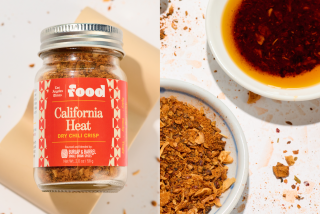Seasonal Cooking : IN THE KITCHEN : Roasted Peppers: Fall Color on a Plate
Southern California is a marvelous place to live in many ways, but we don’t have great fall color. How could we, when the temperatures can soar to the mid-90s at any time? Here, if you want to ooh and aah over the brilliant scarlets and golds of autumn, you’ve got to look for it on the plate.
To me, there is not a more perfect food for fall than roasted peppers. They have deep, saturated colors. They have the texture of butter with none of the fat. They have an intense flavor that needs little ornamentation. And they’re easy to fix.
They’re a perfect example of what Michael Roberts calls “a cashmere throw” of a dish--at the same time casual and elegant. To me, roasted peppers are among those mysterious dishes (like sliced tomatoes) that are perfect in their simplicity. They defy cooking. In and of themselves, they are sufficient, and any attempt at a cook’s “improvement” is more than likely going to be to their detriment.
Make no mistake, these peppers bear little resemblance to the jars of roasted peppers you’ll find in the store. So they can be preserved without freezing or refrigeration, these commercial peppers are treated with citric acid, which contributes a bitter tingle. They’re fine for sub sandwiches, but you wouldn’t want to serve them by themselves.
A friend says that when she uses store-bought peppers, she first rinses them off and then throws them on the grill. Actually, homemade roasted peppers are even easier than that. You take your peppers and grill them until they’re black. Then you peel them. While you’re peeling them, the seeds and stems will come off. Don’t worry about being too thorough; a few seeds and bits of charred skin add flavor and a nice textural difference.
Toss the roasted and peeled peppers into a bowl with a bit of garlic, a little olive oil and a dash of salt and pepper. Stir and let stand for a couple of minutes. When you come back, you’ll see the peppers glowing with a thick, oily shine. That’s the juices they exude. As far as fat goes, it’s nearly a freebie.
Try to use a variety of colors of peppers. Greens, of course, are the cheapest, but their flavor is not as rich. Reds are more affordable than they used to be and should be the bulk of the salad. Yellows are still pretty expensive, but just one or two will add a great splash of color. The finished dish has the deep, velvety tones of a Rembrandt.
Homemade roasted peppers are wonderful by themselves or on bread, and if you have a little fresh goat cheese, so much the better. They’re also good served with other grilled vegetables--particularly eggplant. Try making a sandwich of grilled eggplant, roasted peppers, some sliced tomatoes and tangy ricotta salata.
You can also use them in more complicated dishes, though care must then be exercised in peeling them. After roasting, the flesh is delicate and has a tendency to tear when you rub off the charred skin. Patience has its rewards, though. I remember once in Italy eating a wonderful cold roasted pepper stuffed with a caper-y tuna salad. Call it lily-gilding if you like, but it was delicious.
Still, as with all good things, the simpler the preparation, the better. I just finished eating a piece of good bread spread with a bit of goat cheese and topped with some roasted peppers and . . . OK, I just got back from eating another one . . . . I can’t imagine anything more delicious.
*
Now, colored peppers are available almost all year round, thanks to innovative farming. But it seems like only yesterday that I would celebrate September by buying a case of peppers and firing up the barbecue so I could roast and peel them. Then I’d stick the peppers in little plastic bags and freeze them because I knew that two or three weeks later, fresh red and yellow peppers would disappear from the market.
This is a tarted-up roasted pepper recipe. The fried garlic and pine nuts add texture and a lingering flavor that’s very nice. But if you prefer, just forget them. Put them out of your mind. You don’t need them. Roasted peppers are fine just the way they are.
*
ROASTED PEPPERS
2 sweet red peppers 2 sweet green peppers 2 sweet yellow peppers 2 cloves garlic, thinly sliced lengthwise, plus 1 teaspoon minced 2 tablespoons extra-virgin olive oil Salt Freshly ground pepper 2 tablespoons lightly toasted pine nuts
Under broiler or on barbecue grill, roast peppers until skin blackens. Turn and repeat until all sides and bottoms are blackened or visibly pulling away from flesh. As peppers are done, remove from broiler and put in plastic food bag. Let cool 10 minutes.
Using fingers and no running water, slip thin layer of charred skin from peppers. Remove tops and cores from peppers and cut peppers into thick strips. Remove most seeds and veins. Combine all peppers in bowl with minced garlic and set aside.
Heat olive oil in skillet until very hot. Add thinly sliced garlic and cook until well browned. Do not let garlic blacken. When done, remove garlic slices from oil to drain on paper towels. Gently pat dry. Lightly season to taste with salt. Reserve oil and let cool.
Add 1 tablespoon reserved cooking oil to peppers, and add salt and pepper to taste. Combine well. Adjust seasonings to taste. Sprinkle top with fried garlic slices and pine nuts. Serve at room temperature. Makes 4 servings.
Each serving contains about:
114 calories; 77 mg sodium; 0 cholesterol; 9 grams fat; 8 grams carbohydrates; 2 grams protein; 0.44 gram fiber.
More to Read
Eat your way across L.A.
Get our weekly Tasting Notes newsletter for reviews, news and more.
You may occasionally receive promotional content from the Los Angeles Times.











